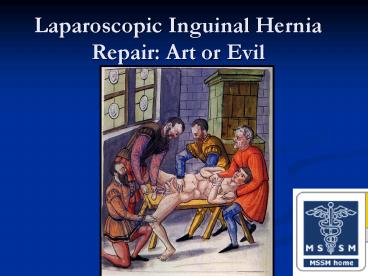Laparoscopic Inguinal Hernia Repair: Art or Evil - PowerPoint PPT Presentation
1 / 27
Title:
Laparoscopic Inguinal Hernia Repair: Art or Evil
Description:
TEP (Totally ExtraPeritoneal) repair. ... This is probably the most physiological repair although technically more demanding. ... – PowerPoint PPT presentation
Number of Views:2701
Avg rating:3.0/5.0
Title: Laparoscopic Inguinal Hernia Repair: Art or Evil
1
Laparoscopic Inguinal HerniaRepair Art or Evil
2
Inguinal Hernias
- How common are they?
- - 700,000 inguinal hernia repairs performed in
the US per year
3
Inguinal Hernia
- Types Indirect Direct -- separated by inf
epigastric vessels
4
Open Inguinal Hernia Repairs
- Bassini
- McVay
- Shouldice
- Lichtenstein
- Plug patch
5
Lichtenstein Repair
- Popularized the use of polypropylene mesh in
primary hernia repairs - Mesh is laid over the undisturbed inguinal floor,
posterior to the spermatic cord sutured to the
shelving edge of the inguinal ligament, internal
oblique fascia and the pubis
6
(No Transcript)
7
Laparoscopic Hernia Repair
8
When is laparoscopy appropriate?
- Recurrent hernias - avoid a prev operated field
- Bilateral hernias - one set of incisions better
than two inguinal incisions one mesh to cover
both overlay bladder
9
Types of Laparoscopic Inguinal Hernia Repair
- IPOM (IntraPeritoneal On-lay Mesh) repair. A
mesh is placed intra-abdominally covering the
hernia defect and then secured to the abdominal
wall. Very popular at the beginning of
laparoscopic experience, it has since been
abandoned. - TAPP (Trans Abdominal Pre-Peritoneal) repair.
With this technique, the pre-peritoneal space is
accessed from the abdominal cavity and a mesh is
then placed and secured. This is procedure of
choice for recurrent inguinal hernias or in case
of incarcerated bowel visualized. - TEP (Totally ExtraPeritoneal) repair. The mesh
is again placed in the retroperitoneal space, but
in this case, the space is accesed without
violating the abdominal cavity. This is probably
the most physiological repair although
technically more demanding. The procedure of
choice for bilateral inguinal hernia repairs
10
Trochar placement for both TEP TAPP
11
Anatomy
12
(No Transcript)
13
(No Transcript)
14
What does the literature say ?
15
Comparison of Conventional Anterior Surgery and
Laparoscopic Surgery for Inguinal-Hernia
RepairMike S.L. Liem, M.D., Yolanda van der
Graaf, M.D., Cees J. van Steensel, M.D., Roelof
U. Boelhouwer, M.D., Geert-Jan Clevers, M.D.,
Willem S. Meijer, M.D., Laurents P.S. Stassen,
M.D., Johannes P. Vente, M.D., Wibo F. Weidema,
M.D., Augustinus J.P. Schrijvers, Ph.D., and Theo
J.M.V. van Vroonhoven, M.D.
- Multicenter randomized prospective trial
- Sample 487 (TEP-mesh) 507 (open-no mesh)
- Postop f/u 1 6 weeks, 6 mo, 1 2 years
16
(No Transcript)
17
(No Transcript)
18
(No Transcript)
19
(No Transcript)
20
Conclusion
- Patients with inguinal hernias who undergo
laparoscopic repair recover more rapidly and have
fewer recurrences than those who undergo open
surgical repair
Liem et al. Comparison of Conventional Anterior
Surgery and Laparoscopic Surgery for
Inguinal-Hernia Repair. NEJM. 1997. 336.
1541-7.
21
Open Mesh versus Laparoscopic Mesh Repair of
Inguinal Hernia Leigh Neumayer, M.D., Anita
Giobbie-Hurder, M.S., Olga Jonasson, M.D., Robert
Fitzgibbons, Jr., M.D., Dorothy Dunlop, Ph.D.,
James Gibbs, Ph.D., Domenic Reda, Ph.D., William
Henderson, Ph.D., for the Veterans Affairs
Cooperative Studies Program 456 Investigators
- VA Multicenter randomized prospective study
- N 3518 (eligible) ? 2164 (randomization) ?
- 1983 (surgery) ? 1696 (2 yr f/u)
22
(No Transcript)
23
(No Transcript)
24
(No Transcript)
25
(No Transcript)
26
Conclusions
- Higher recurrences in laparoscopic group for
primary (same for recurrence repairs) - Increased intra-op/postop complications in the
laparoscopic group - Earlier return to usual activities in lap. Group
- Recurrence rates for lap surgeons threshold was
250 repairs
Leigh Neumayer, M.D Open Mesh versus Laparoscopic
Mesh Repair of Inguinal Hernia. NEJM. 2004
3501819-27
27
Limitations
- VA population
- Variability among surgeons performance
- Surgeons experience was self-reported
Leigh Neumayer, M.D Open Mesh versus Laparoscopic
Mesh Repair of Inguinal Hernia. NEJM. 2004
3501819-27































